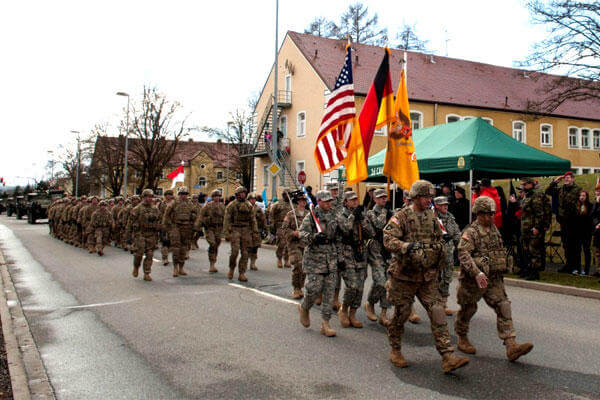NATO rift: US troops leaving Germany. On the 29th of July 2020, the Pentagon moved forward with President Trump’s wish to relocate US troops out of Germany. 11,900 US soldiers are to be pulled out of Germany. This includes 6,500 sent back to the States (with 4,500 of those coming from the U.S. Army’s 2nd Cavalry Regiment) and 5,400 relocating to other European nations. The move will leave between 24,000 and 25,000 US troops stationed in Germany.
But where will those 5,400 troops staying in Europe be relocated? For a start, EUCOM headquarters will move from Germany to Belgium in an effort to co-locate it with NATO military command headquarters (SHAPE), near the city of Mons. Three brigade-size headquarters, an air defense artillery battalion, and an engineering battalion will also follow to Belgium.
Two smaller support and contracting organizations are scheduled to move to Italy. They might be joined there by two battalions and possibly by the 480th Fighter Squadron. The 480th is comprised of 20 F-16CJ/DJ and is currently based at Spangdhalem AB. Should it be moved to Italy, it would certainly establish its quarters to Aviano Air Base. This particular move is not 100% certain as those F-16 could also be relocated to Spain. Africa Command headquarters may be moving to a location yet to be determined, as well.
The official reason given is that Germany does not respect its commitment to invest 2% of its GDP into its defence budget. The argument is not new: In August 2019, the American Ambassador to Germany stated: “It is actually offensive to assume that the US taxpayer must continue to pay to have 50,000-plus Americans in Germany, but the Germans get to spend their surplus on domestic programmes.”
This last sentence shows that from the American point of view, the “German problem” is not confined to the matter related to defence spending. It is a little bit more complex than this and in reality, has more to do with economic matters. Trump had already lashed out against the US trade deficit with Germany back in 2017, stating that “things would change.” Back then, he had threatened to impose 35% tariffs on German-made cars, stating that more of those needed to be produced in the US, rather than being imported. America is locked in a quasi-trade war against the world in general and its European partners in particular. The skirmishes in this trade war have not only involved German cars, but also French wines, champagnes, and cheese, which were all threatened with tariffs in December 2019. The charges would cover French imports worth $2.4bn. The ultimate aim? making French goods less attractive to US consumers as they could double in prices! Another battleground where this trade war is being fought involves gas… And Germany is once again involved!

The main bone of contention, here, is called Nord Stream 2 and involves a pipeline project aimed at doubling the existing gas transit capacity between Russia and Germany up to 110 billion m3! Nord Stream involves Russia (though Gazprom), Germany (through Uniper and Wintershall), the Netherlands (Gasunie) and France (Engie). This project is a Win-Win for both Western Europe and Russia:
- It cements Russia’s position as Europe’s number one gas supplier.
- It would also enable Russia to bypass Ukrainian pipelines, costing Kiev $2-3 billion in revenue from transit through its gas transportation system. This sum represents almost 3% of the country’s GDP.
- It would guarantee a reliable supply of cheap gas to Western Europe.
Unsurprisingly, the US opposes this project. And so do Poland and Ukraine. Washington slapped sanctions against European companies taking part in pipe-laying activities linked to Nord Stream 2 in December 2019. The project is now entering the second round of American sanctions under the National Defense Authorization Act. From Washington’s point of view, time is of the essence, as Russian ships have taken over pipe-laying work, and the pipeline is now 90% complete.
But why is Washington opposed to Nord Stream 2? That’s partly because the project would bring in hard currency to Moscow. It is also partly in support of Kiev, whose fragile economy would be badly impacted by this project once completed.
But… It also has to do with American ambitions in the gas market and its will to impose American shale oil and shale gas on its European partners. “Europe can buy its gas wherever it wants, but the U.S. should be among the array of suppliers,” a top US energy official told CNBC in February 2020.
Washington is acutely aware that with Nord Stream and Nord Stream 2 in operation, Russian gas would simply be much cheaper than US shale gas (it already is). American sanctions aim to threaten the Nord Stream 2 project by making it too costly for the European oil majors involved. The costs associated with US sanctions would in theory make US gas a more attractive proposition, despite its higher price.
In August 2020, 3 American senators upped the ante and threatened to impose “crushing legal and economic sanctions” on the German port of Sassnitz (Baltic Sea). Sassnitz is the main hub for Nord Stream 2 logistics and hosts Russian vessels and building materials involved in the construction of the pipeline. The three US senators warned the US sanctions would be obligatory and “destroy the financial survival” of German businesses involved in the project.
However, those sanctions have so far failed to sway Western European nations in favour of US shale gas. Interestingly enough, while on the one hand, Washington threatens its allies with sanctions for buying Russian petroleum products, on the other hand, US refineries are literally hooked on Russian crude: They imported 11 million tons of it in 2019 alone and the figure is set to be higher, still, for 2020. The reasons? Sanctions on Venezuela have strangled the global supply of heavy crude. As for Russian petroleum products, they are currently cheap and so are the freight rates associated with it!
In this context, it is not hard to see Washington’s decision to move US troops out of Germany as yet another punishment dished out to Berlin or as another attempt at twisting its ally’s arms. The sole excuse that Germany is “Delinquent” and fails to meet its defence spending commitment to NATO is very thin indeed: Traditionally, very few countries ever meet NATO’s 2% defence related spending target. Only 7 out of 27 member states hit said the target for 2019: Estonia, Greece, Latvia, Poland, Romania, the UK, and the United States. And this figure is only achieved thanks to a little accounting trick on the part of the United Kingdom: In 2015, amid budget cuts, the UK changed how it calculated its defence spending. Its defence budget as a share of GDP had fallen to 1.97%. So the Brits added war pensions, contributions to UN peacekeeping missions and pensions for civilian Ministry of Defence personnel to the basket. With this neat little trick, the United Kingdom “added” over £1 billion in defense-related spending to their budget, thus achieving NATO’s 2% target.
If washington had to pull out of every “delinquent” European NATO member state, it would leave Western Europe free of American troops and NATO basically hollowed out as an alliance. The situation is summed up in this snapshot: US troops are being removed from “delinquent” Germany and being relocated to Italy and Belgium, two countries that contribute even less toward defence spending than Germany does!

Putting aside this little trade war amongst NATO friends, the decision to remove some troops from Germany and redistribute them elsewhere in Europe might make more sense tactically speaking: “The current EUCOM plan will reposition approximately 11,900 military personnel from Germany, from roughly 36,000 down to 24,000, in a manner that will strengthen NATO, enhance the deterrence of Russia, and meet the other principles I set forth,” United States Secretary of Defense Esper told reporters. In August, he added “The bottom line is: we basically are moving troops further east, closer to Russia’s border to deter them.”
Indeed, it seems that some US troops will be headed toward the Baltic states, Poland and Romania. While most of those would be on a rotational basis, Poland, which has long demanded more US forces on its territory to deter/poke the Russian bear will see its wishes granted: Last summer, U.S. President Donald Trump and Polish President Andrzej Duda agreed in principle for an increase in U.S. boots on Polish ground. Negotiations started immediately on costs and who would pay for what. Washington has always been enthusiastic with regards to a move East closer to Russia: Back in 2019, the US ambassador to Poland joined in by tweeting: “Poland meets its 2 per cent of GDP spending obligation towards NATO. Germany does not. We would welcome American troops in Germany to come to Poland”.
It seems an agreement has finally been reached and that Poland will foot the bill for most of it: Poland currently hosts a rotating contingent of over 4,000 U.S. troops. The new agreement will see an additional 1,000 to 1,500 US troops be moved from Germany to Poland to form a permanent presence. Those American troops will represent forward elements of the U.S. Army’s V Corps headquarters as well as a Division headquarters. The Americans will bring with them intelligence, surveillance and reconnaissance capabilities. Warsaw has promised to finance and build the infrastructure to support an armored brigade combat team and combat aviation brigade as well as a joint-use Combat Training Center in Drawsko Pomorskie. Poland will also have to supply facilities for an Air Force MQ-9 drone squadron, an aerial port of debarkation to support the movement of forces in and out of the country and facilities to support special operations forces so they can conduct air, ground and maritime operations.










